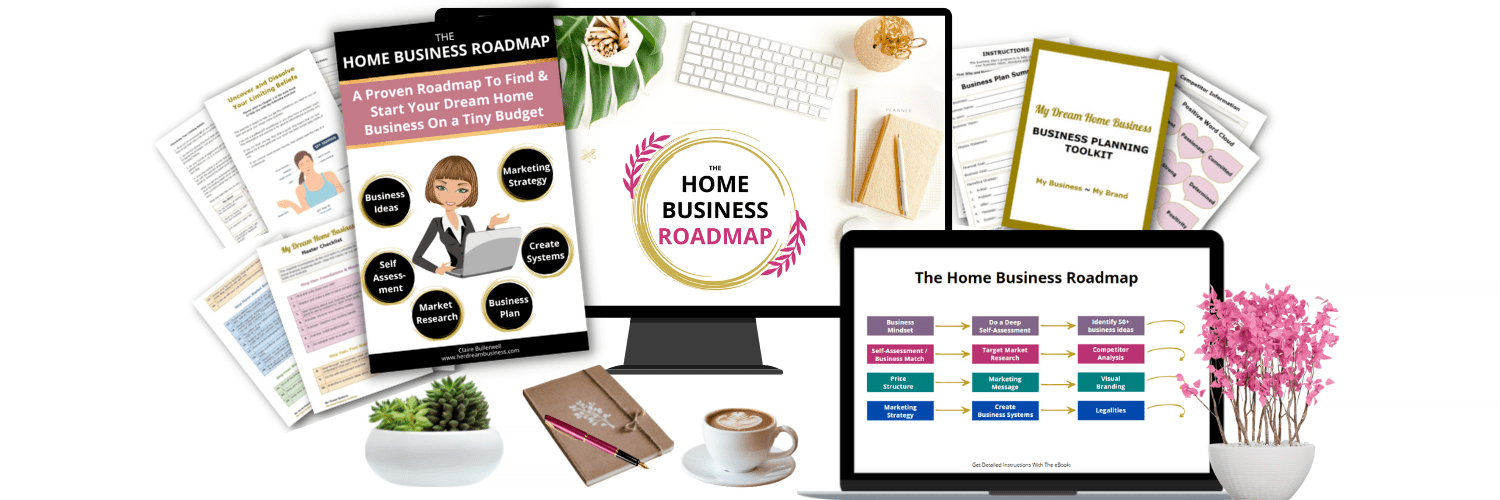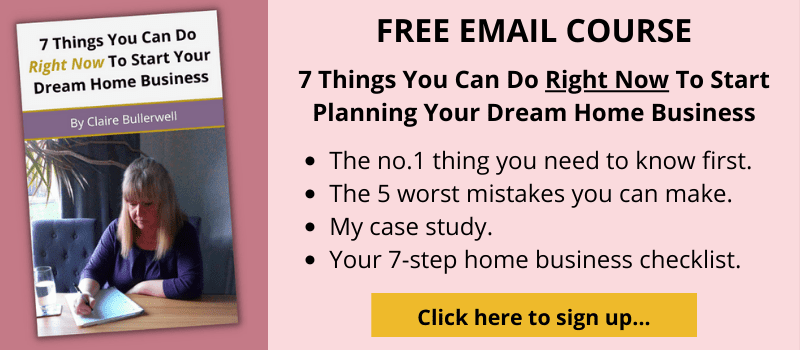If you’re asking the question “Do I need to create a business plan for a small home-based business?“, then know that you’re not the only one asking that question and that I definitely know where you’re coming from!
Because for years I had no idea that I should have created a business plan for most of my small home-based businesses; all being ran by me as an independent business owner.

I’ll not go into the how’s and why’s of why I didn’t create business plans here, but know that I did eventually come to my senses and I did indeed create a business plan to start this business blog which you’re reading now.
So here’s the direct answer to your question…
Question: “Do I need to create a business plan for my home based business?”
Yes, you need to create an informal business plan for your home business. When you’re running a small business from home, you still need to have a roadmap of where you are now and where you want to be with your business, and this is easily accomplished with a business plan just for your eyes only.
To help you understand this process further, let’s look over:
- The Difference Between a Formal and Informal Business Plan.
- Why An Informal Plan is Essential To Your Business Success.
- What Happens If You Don’t Create a Business Plan.
- The Eight Major Components of Your Business Plan.
- What To Do After You’ve Completed Your Business Plan.
- Why Your Business Plan Is Never Finished.
- What Next?
The Difference Between a Formal and Informal Business Plan
When you first think of a business plan, you automatically envisage some long, formal document which needs to be created by a business expert.
The truth is, this isn’t necessarily the case as there are two types of business plans, and both have their own place.
Formal Business Plan
A formal business plan is where you need to present it to the bank, or potential investors, because you’re asking for help with startup capital.
The purpose of this type of business plan is to show that your business will become a success and that you’ll be able to pay the borrowed money back.
I created a formal business plan when I started my domestic cleaning company. I needed startup capital from the bank to buy a car for my cleaning team of two cleaners, cleaning products, and have a marketing budget in place.
Needless to say, this type of business plan needs to be extremely detailed and written in a very formal manner.
A formal business plan outline will be something like this:
- Executive Summary
- Business Description
- Market Analysis
- Competitor Analysis
- Your Product or Service
- Pricing
- Marketing Plan
- Employee Information
- Spreadsheet With Financial Forecast
So you have to do as much research as you possibly can to ensure that your document is as realistic as it can be, given that most of it is a forecast.
Informal Business Plan
An informal business plan however, it a totally different document altogether.
If you’re looking to start a home based business, then you will not likely be borrowing a large amount of money to get started, because the majority of home-based businesses can be started with very low investment.
So in this scenario, you will only need to do research and create a business plan just for your benefit only, and so it doesn’t need to be formal.
Why An Informal Plan is Essential To Your Business Success
I see this all the time in ‘women in business’ and ‘female entrepreneur’ types of Facebook groups…
Somebody has a business idea, and has probably done some research into it. She then goes into a Facebook group and asks where to get a logo created, or if she needs a website setting up.
She then gets a lot of answers to her questions, but some savvy ‘business coaches / strategists’ answer with:
- Have you done your customer avatar research?
- Do you know who your competitors are?
- Have you drawn up a business plan?
And more than likely, they haven’t done any of the above, or not in any great detail.
Your Business Roadmap
Just because you’re running a small business from home, and not renting a shop or an outlet, it doesn’t mean that you should not create a detailed business plan.
An informal business plan is your roadmap; which maps out where you are now, where you want to be, and how to get there.
This roadmap acts as a big business checklist so you don’t miss out any essential startup tasks.
I actually enjoyed the process of creating my own informal business plan because:
- It made my little home business seem real – before I launched it.
- It was not stressful creating it – because it was for my eyes only.
- I knew exactly what I had to do to get started, and in what order.
So do yourself a favor, and create an informal business plan now, before you start or launch your business.
What Happens If You Don’t Create a Business Plan
In a nutshell, you will:
- Be stressed.
- Have no direction.
- Have daily chaos.
- Go round-and-round in circles.
- Won’t know what step to take next.
- Be setting yourself up for failure.
And believe me, I know this from experience of not creating business plans for some of my home business ventures.
Yes it takes some time to do all the research, but it is definitely worth it in the long run.
The Eight Major Components of Your Business Plan
So now you know that you need to create an informal business plan for your home based business, let’s look at what needs to be included.
1. Business Idea
First and foremost, you need to be happy with your choice of business idea.
I know that this sounds ‘obvious’, but believe me from experience – it’s not.
I’ve written a few different blog posts about this – because it’s very important – but the main takeaway point here is to do a self-assessment and choose a business idea which suits you personally.
Related Reading:
2. Target Market Research
You need to know exactly who your target market are. Who are you going to sell to?
You really need to know the ins and outs of your target market, because you’ll be finalizing your product/service around them, and then creating a marketing message(s) to grab their attention.
If you look at the customer avatar exercise (plus free worksheet), you’ll see that you need to drill down your target market into one person.
Not all of your target market will want to buy your product or service as there will be many different clusters of people within your target market. So it’s essential you find that one customer avatar who will happily buy your product, because it will solve her very specific problem.
>> Go and take a look at the customer exercise here.
3. Competitor Analysis
You then need to do the same type of research and analysis on your competitors.
You need to know who you customers are and identify their strengths and weaknesses, so you can outdo them on their weaknesses and match them, or take an alternative twist, on their strengths.
Price Structure
Another reason to analyze your competitors is to find out what they’re charging for their product/service; so you can price your product accordingly.
But please don’t think that you need to undercut them just to make your product more appealing to your customer avatar.
It doesn’t.
If anything, if you price your product too low, it will psychologically backfire on you.
People will think that you’re charging lower than your competitors because your product is not on par with theirs.
Will Your Business Be Profitable?
I just want to quickly add that just because you price your products’ price ‘accordingly’ it still mightn’t make you a big enough net profit for your business to be financially viable.
This goes with the business idea and price structure scenario.
You need to know if your product will make you a big enough net profit for it to be a worthwhile business venture to pursue.
This is why market research and analysis is essential!
I actually give you some examples of how to decide if your business idea is profitable in my Roadmap ebook.
4. Marketing Message
Next, you need to write out your marketing message.
Basically a marketing message are just the words, in a couple of sentences or paragraphs, letting your customer avatar know about you and your business – and most importantly – how your product can help solve their problem/address their needs.
You would then use this same marketing message again and again, in a variety of places where you know where your customer avatar hangs out, in order to get her attention.
5. Visual Branding
Your marketing message is your ‘words’ branding, and so visual branding is your visual imagery.
It is your visual identity that represents your overall brand.
Visual branding consists of elements such as:
- Colors
- Typography
- Imagery, and
- Graphics
All these put together, form a strong visual representation of your business.
Examples of visual branding are:
- Logo
- Website
- Packaging
- Social media graphics
- Advertising & marketing materials
6. Marketing Strategy
Once you have all of your branding in place, it’s then time to create a marketing strategy to sell your product to your ideal customer avatar.
Your marketing strategy must be based on the best way to get your marketing message in front of your customer avatar.
- Does she hang out in Facebook groups?
- Pinterest/TikTok/Instagram/Reddit?
- Does she listen to Podcasts?
- Mainly Watches YouTube Videos?
- Or would offline marketing work best such as leaflet drops or emailing her direct?
So find out where she hangs out online or offline the most, then devise a marketing plan to get her attention.
7. Business Systems
If you don’t want to be running around in chaos like a headless chicken each day, then it’s very wise to set up business systems.
Business systems are to help you become productive and efficient in your business.
You can create business systems for just about any business task or activity in your business:
- Income & expenditure system (Bookkeeping)
- Customer service emails
- Social media marketing system
- General admin
8. Legalities
And lastly, of course you’ll have to make your business legal.
So make sure you look at your local governments website and/or get in touch with your local government office and see what the rules and regulations are for setting up a small business from home.
You’ll also have to look and see if you need any permits, licenses or special insurances for your specific home business.
What To Do After You’ve Completed Your Business Plan
Once you’ve completed your business plan, it’s time to take the next step.
This step will likely be different for each person, so figure out what the best proactive ‘next step’ is for you.
Setup your home office.
Get your visual branding created; logo, website etc.
Map out your marketing strategy in detail.
It would be a good idea to create a checklist of what you have to do next in order of priority.
Why Your Business Plan Is Never Finished
Now that you’ve completed your business plan, you need to be aware that this will need to be reviewed intermittently.
In fact, this business plan will likely be your first draft because you may find that as your start your business, certain areas and tasks might need amending – for whatever reason.
After that, you should go back and review your business plan at month three in your business.
You need to know if you have reached your three-month goal and that you’re on track to reach your six month goal.
You can then decide to review your business plan every three months or every six months.
What Next?
I’ve briefly mentioned my Home Business Roadmap ebook in this blog post, but I would like to formally introduce you to it.
I wrote this book myself based on my own own experiences of finding my perfect home business idea, all the way through to creating an informal business plan.
Part I of the book is based on mindset work and doing the very important self-assessment exercise to help you find your dream home business. It also includes 70+ home business ideas for you to choose from.
Part II of the book is a detailed step-by-step guide showing you how to do your own research and ultimately create your own business plan.
Bonuses: And of course, I simply had to include bonuses to help you further on this exciting journey. One of the bonuses is a free Business Planning Toolkit where you can write down all your research which you’ve done whilst going through the main ebook.
Go here to learn more about how the Home Business Roadmap can help you find and start your dream home business…
Good Luck!
Hi, I’m Claire Bullerwell
I’ve ran dozens of home-based businesses, both offline and online, since my early twenties. I started this blog to share all my wealth of knowledge and experience to help women just like you; to find your dream home business and to live your best life.
Follow me and let’s get acquainted…



